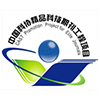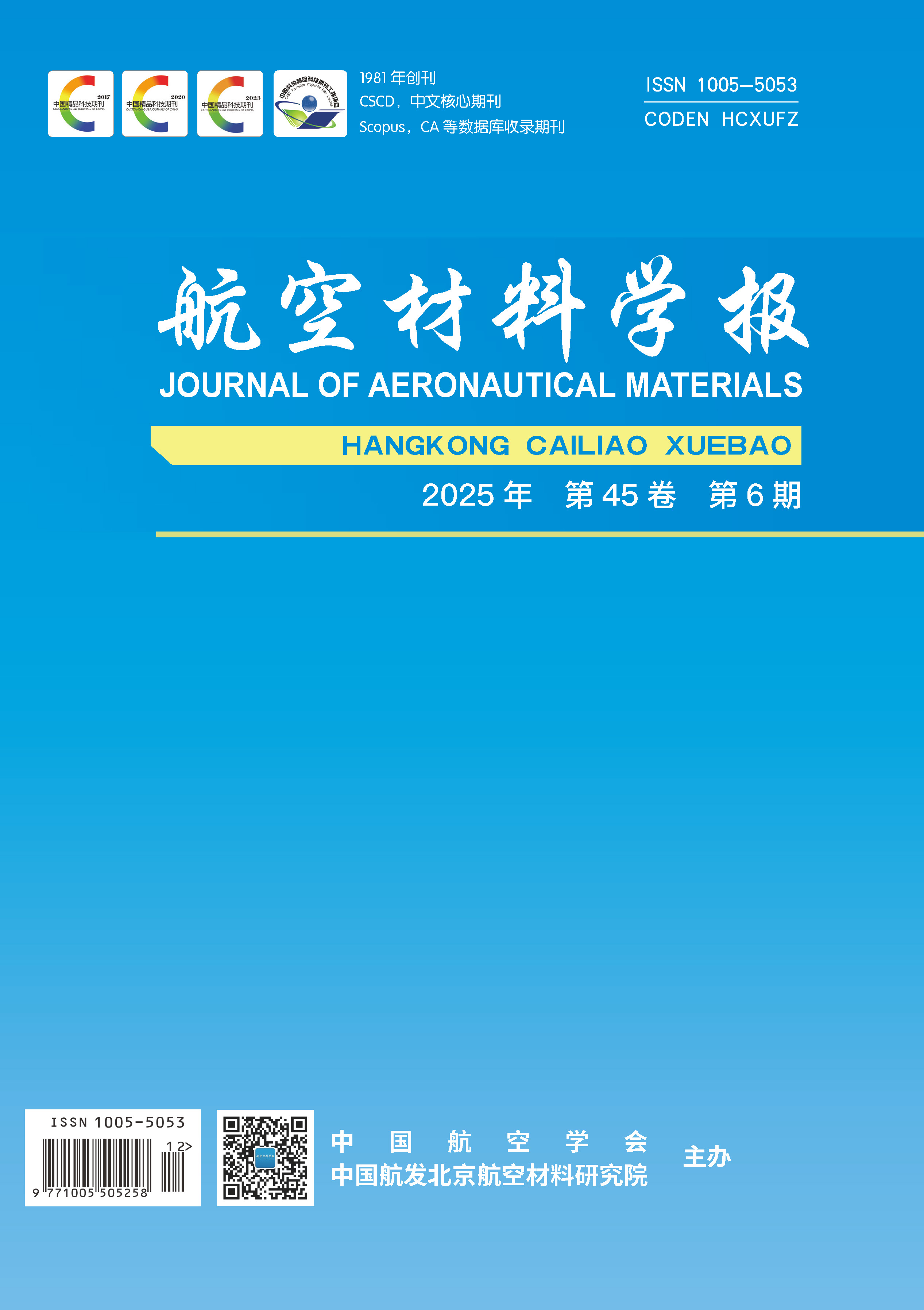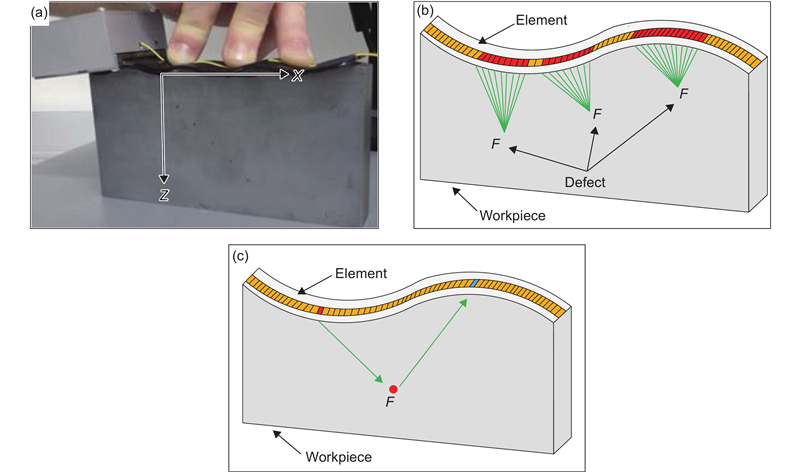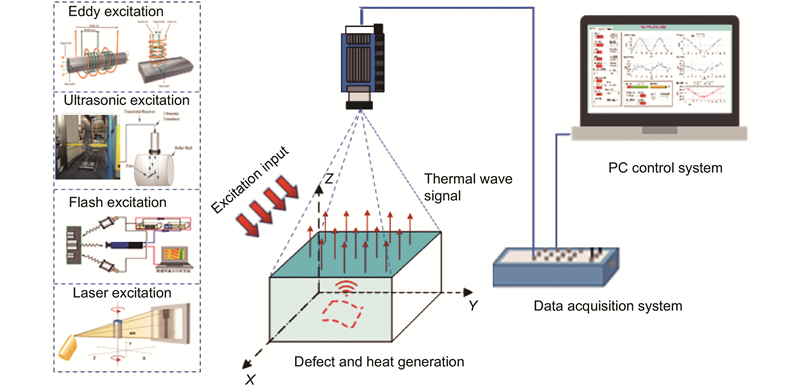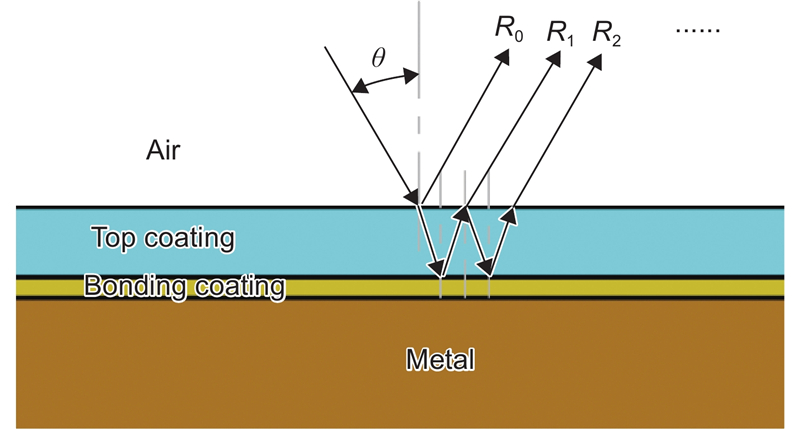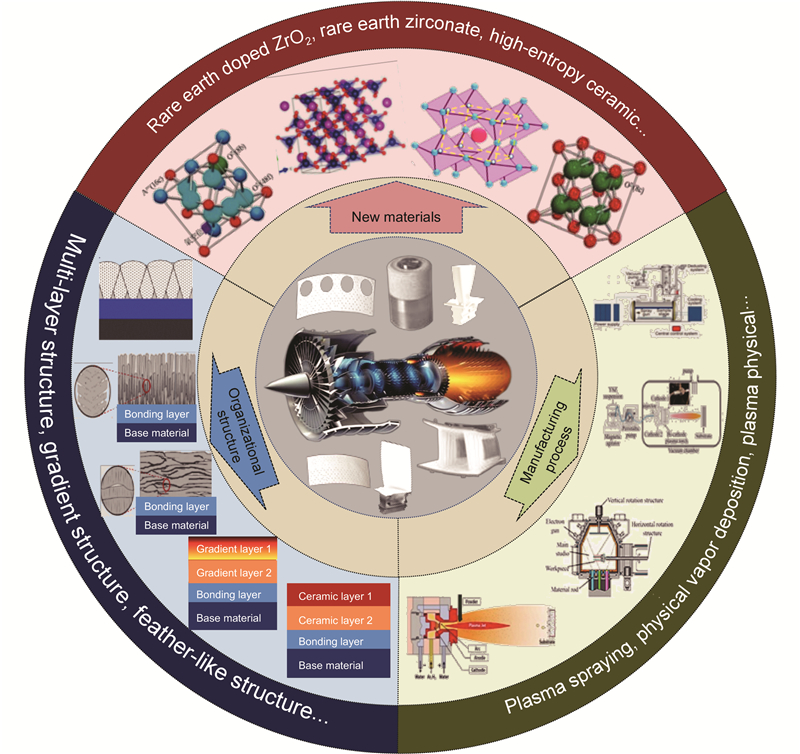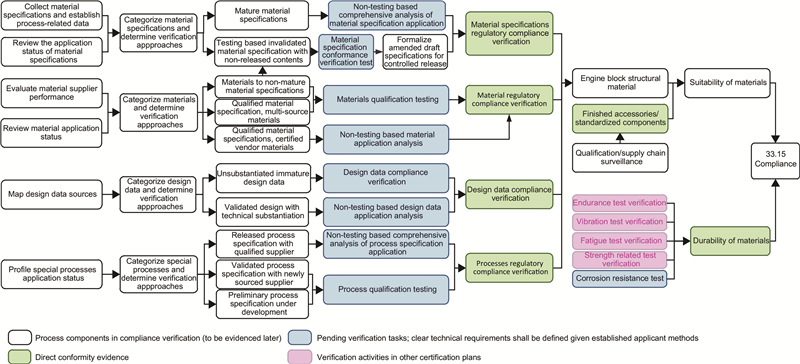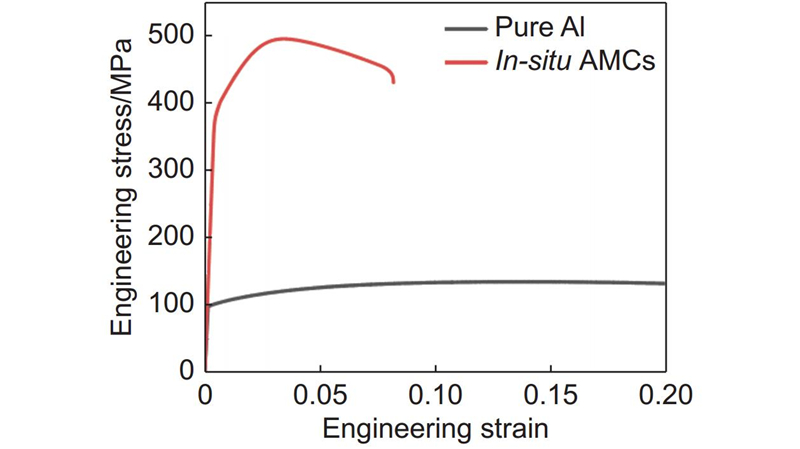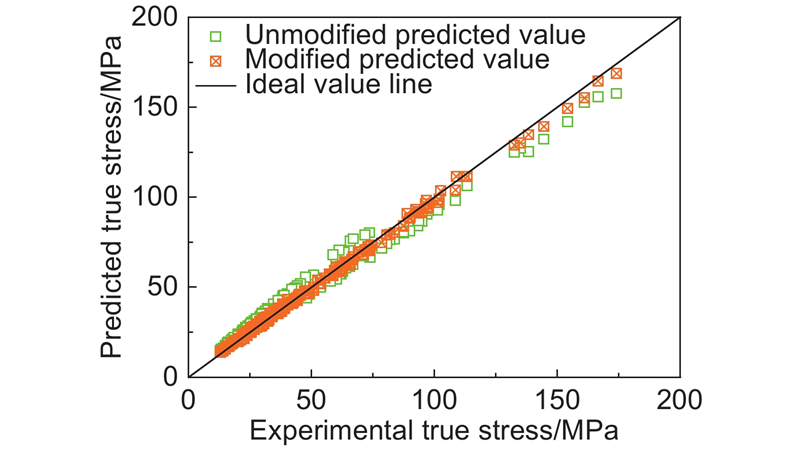Published: 01 December 2025
-
Select all|
-
Non-Destructive Inspection and Evaluation for Advanced Aerospace Equipment2025, 45(6): 1-12. https://doi.org/10.11868/j.issn.1005-5053.2025.000019
Damage detection is a critical link of aviation equipment development, field operation and maintenance, which directly affects the development process and service safety of aircraft structure. In recent years, domestic and foreign scholars and scientific research institutions have carried out a lot of research works in the field of ultrasonic nondestructive testing. Based on this, this paper, guided by the needs of damage detection in the development and operation of aviation equipment, briefly analyzes the characteristics and requirements of typical structural damage of aviation equipment and in-situ detection. This paper focuses on summarizing the latest research progress of ultrasonic theories and methods, advanced detection sensor designs and special detection device research and development. Furthermore, incorporating new issues, ideas and directions emerging from technological research and engineering practice, this paper summarizes and forecasts the main challenges and future development trends in areas such as damage detection technologies for heterogeneous materials, transducer design methods for complex-shaped structures, and the equipment research and development and engineering application of new non-contact testing devices.
-
Non-Destructive Inspection and Evaluation for Advanced Aerospace Equipment2025, 45(6): 13-32. https://doi.org/10.11868/j.issn.1005-5053.2024.000195
Heterogeneous materials are widely used in high-end equipment components of fields such as aerospace, electronic information and national defense, with the microstructure features of multi-phase, multi-scale and complex morphology, which determines the superior macroscopic properties of materials. Establishing an accurate microstructure model is crucial for deeply understanding the structure-property relationship. However, when the material exhibits strong heterogeneous characteristics, the complexity and difficulty of this process increase significantly. In recent years, advances in computational materials science promote the development of computational simulation methods. Microstructure characterization and reconstruction(MCR), as a key component of computational simulation process, provides a powerful approach for microstructure modeling of heterogeneous materials. Currently, MCR for heterogeneous materials mainly includes the following two categories: (1)modeling techniques based on statistical methods; (2)modeling techniques based on machine learning and computer vision. This work summarizes and organizes two categories of MCR techniques, explains the characteristics and applicability of the relevant methods, and analyzes the research progress of different methods in MCR of heterogeneous material. It aims to provide references and guidance for selecting MCR methods and applying them to material design.
-
Non-Destructive Inspection and Evaluation for Advanced Aerospace Equipment2025, 45(6): 33-44. https://doi.org/10.11868/j.issn.1005-5053.2024.000173
Traditional ultrasonic automated non-destructive testing is a great challenge in the inspection of aviation components with complex surfaces. Complex surfaces can interfere with the formation of the focus in the sound beam, and the waveform transformation generated when the sound beam is incident is more complex. All these will lead to a decrease in the ultrasonic testing capability and a significant reduction in the obtained echo signal-to-noise ratio. Under the background of intelligent manufacturing, the development of rapid and low-cost manufacturing of aviation components has been seriously restricted. The paper analyzes the ultrasonic propagation of complex surface media, and summarizes the technical difficulties of automatic ultrasonic detection of complex surface components. The paper also describes the development status of three kinds of automatic ultrasonic imaging detection of complex surfaces, which are based on flexible phased array ultrasonic probe, ultrasonic C-scan imaging detection based on industrial robot and phased array ultrasonic imaging detection for complex surfaces. The advantages and limitations of three kinds of automated ultrasonic imaging detection are analyzed, and the challenges faced by various ultrasonic imaging technologies are reviewed. The key technology to break through the automatic ultrasonic imaging detection of complex aerospace components under the background of intelligent manufacturing is proposed. The paper introduces the future technical requirements for the development of advanced imaging algorithms for automated inspection and the intelligent recognition and classification of defects in the ultrasonic testing of complex aviation components. The key detection technologies based on digital twin detection path planning and the design and manufacture of massive channel phased array ultrasonic sensors, which are urgently needed to be broken through under the background of intelligent manufacturing, have been proposed.
-
Non-Destructive Inspection and Evaluation for Advanced Aerospace Equipment2025, 45(6): 45-59. https://doi.org/10.11868/j.issn.1005-5053.2024.000197
Infrared thermal wave imaging detection technology has the advantages such as high efficiency, large detection area, and non-contact operation, making it widely used in the field of damage detection and evaluation of new materials in aviation and aerospace. This study introduces the principle, implementation approach and applicable conditions of typical infrared thermal wave imaging detection technology, covering various typical infrared thermal wave detection techniques such as pulse infrared thermal imaging, phase-locked infrared thermal imaging, frequency modulation thermal wave imaging, ultrasound assisted infrared thermal wave imaging, eddy current excitation infrared thermal wave imaging, and infrared thermal wave tomography imaging. In addition, the article also explores the current development status of infrared thermal wave non-destructive testing technology in the aerospace field, and lists practical application cases. Finally, this paper analyzes the main challenges faced by infrared thermal wave nondestructive testing technology and outlines its future development trends. The technology is evolving toward diversified excitation sources, intelligent detection, and deeper information integration: excitation sources will develop from single photothermal excitation to multi-physics collaborative excitation incorporating ultrasound, laser and electromagnetic methods; the detection process will integrate novel imaging technologies with artificial intelligence algorithms to achieve precise identification of subtle defects; information processing will leverage multi-source heterogeneous data fusion to overcome the limitations of single-technique approaches and enhance capabilities for quantitative defect detection and three-dimensional reconstruction.
-
Non-Destructive Inspection and Evaluation for Advanced Aerospace Equipment2025, 45(6): 60-67. https://doi.org/10.11868/j.issn.1005-5053.2025.000025
To investigate the feasibility of applying the terahertz time-domain spectroscopy (THz-TDS) thickness measurement method for thermal barrier coatings in automated profiling inspection, and to understand the influence of factors such as measurement incidence angle, lift-off distance, coating refractive index and substrate curvature on thickness measurement results, theoretical analysis and experimental studies based on various test blocks are conducted. The results demonstrate that when the incident angle varies with in the range of −3° to +3°, the relative deviation in thickness measurement compared to the zero-angle condition is within 0.5%. Variations in lift-off distance within ±1.5 mm result in a relative deviation within 2.6% compared to the focal position. The refractive indexs of coatings show notable variations across different sample batches, with the maximum relative deviation exceeding 6% among ten tested samples. However, the refractive index remains highly consistent across individual samples, with relative deviations largely within 2%. Experiments on curved substrates with diameters of 5 mm and 6 mm reveal that while substrate curvature reduces the maximum amplitude of the reflected wave, it does not affect the accurate identification of the time-of-flight. In summary, the THz-TDS thickness measurement method demonstrates feasibility and significant engineering application value for automated profiling detection of thermal barrier coatings on blades.
-
Review2025, 45(6): 68-80. https://doi.org/10.11868/j.issn.1005-5053.2025.000143
The operating temperatures of hot-section components in advanced aero-engines continue to increase, accompanied by increasingly severe service conditions. Conventional thermal barrier coatings(TBCs)can no longer meet these demanding requirements, necessitating the development of new TBCs with higher temperature resistance and superior overall performance. This paper systematically analyzes the application requirements for new thermal barrier coating materials in advanced aero-engines, focusing on material composition, fabrication processes and microstructure. It elaborates on recent research progress in three types of novel TBCs: rare-earth-doped ZrO2 coatings applied via atmospheric plasma spraying(APS), rare-earth zirconate coatings produced by electron beam physical vapor deposition(EB-PVD), and high-entropy ceramic coatings fabricated through plasma spray-physical vapor deposition (PS-PVD). Compared to traditional double-layer structured yttria-stabilized zirconia(YSZ) TBCs, these new coating systems—based on rare-earth-doped ZrO2, rare-earth zirconates, or high-entropy ceramics—exhibit lower thermal conductivity, enhanced thermal shock resistance, and superior resistance to calcium-magnesium-alumino-silicate (CMAS) corrosion. Through in-depth integration with processes such as APS, EB-PVD and PS-PVD, the performance of these coatings has been significantly improved, making them suitable for application in critical hot-section components like floating wall tiles and turbine blades. As breakthroughs continue to emerge in new materials, structures and processes, these advanced thermal barrier coatings are poised to provide crucial support for next-generation aero-engines, enabling them to surpass current temperature limits and achieve greater efficiency and reliability.
-
Review2025, 45(6): 81-88. https://doi.org/10.11868/j.issn.1005-5053.2025.000157
Materials and processes form the foundation of manufacturing development, especially for civil aviation products, whose design, verification and airworthiness certification are inseparable from the support of material data. Despite significant progress in domestic material and process technologies in recent years, material airworthiness certification of civil aero-engines still faces the challenges of insufficient verification data due to an incomplete material system and inadequate accumulation of historical data. The current primary contradiction is manifested as the conflict between the high requirements of civil aircraft airworthiness for materials/processes, the insufficient support capacity of the domestic material system, and the urgency of solving problems. This paper analyzes the core requirements of airworthiness regulations such as CCAR33.15 “Materials”, compares the current situation of domestic and foreign material/process airworthiness certification, and identifies gaps of China in material specification statistical validation, process control mechanisms, design allowable value generation and special processes. Combining practical issues in certification practice, a technology scheme based on national conditions is proposed. Relying on the national collaborative innovation mechanism, a five-dimensional implementation path of “Regulation interpretation-system collaboration-multi-party linkage-technical synergy-dynamic adaptation” is constructed. It promotes the improvement of enterprise material systems through type projects and accurately acquires verification data oriented toward design requirements. Practice shows that this scheme has promoted the completion of over 600 material and process tests, established more than 100 material specifications and over 1000 design performance curves, effectively supporting the type certification work. The research results provide technical references for improving the management of material/process airworthiness certification of civil aero-engines and promoting the application of independent materials.
-
Research Paper2025, 45(6): 89-100. https://doi.org/10.11868/j.issn.1005-5053.2025.000117
Refractory high-entropy alloys(RHEAs) are widely used in the aerospace field due to their excellent high-temperature performance. This study employs multi-wire arc additive manufacturing(M-WAAM) technology to fabricate Ta1.5Mo1.5Nb0.5Zr2Ti refractory high-entropy alloy. Using equipment such as optical microscopy(OM) and high-speed cameras, the influence rules of base current, peak current, and peak time ratio on forming quality are investigated. The optimal process parameters for preparing the Ta1.5Mo1.5Nb0.5Zr2Ti alloy are determined(base current 100 A, peak current 300 A, and peak time ratio 35%). Metallographic characterization demonstrates that the fabricated components exhibit excellent forming quality, with unmelted area ratio below 10% and porosity less than 0.5%. To address the melting point differences among various wires, hot-wire technology is employed to facilitate the melting of high-melting-point Ta/Mo wires. For the first time, we propose a“single droplet pre-alloyed transfer”mechanism, elucidating the thermodynamic process of discontinuous liquid bridge transition and subsequent formation of a unified molten droplet from four simultaneously fed wires. Based on the thermodynamic mechanism of synchronous four-wire discontinuous liquid bridge transition forming a unified molten droplet, a“single droplet pre-alloyed transfer”mode is established. Parts deposited under this droplet transfer mode demonstrate good macroscopic morphology and fewer internal defects. Through force analysis of molten droplets, we establish a mechanical model incorporating key factors including gravity, electromagnetic force, and plasma flow force, demonstrating that synchronous non-continuous liquid bridge transition of four wires constitutes a sufficient condition for the formation of a unified molten droplet. Additionally, the developed bead width prediction model provides quantitative guidance for process optimization. This work establishes an important theoretical foundation for M-WAAM of RHEAs.
-
Research Paper2025, 45(6): 101-108. https://doi.org/10.11868/j.issn.1005-5053.2025.000052
In-situ nano-Al-O reinforced aluminum matrix composites are fabricated via the powder hot extrusion method, and their distinctive microstructural attributes are examined to ascertain their impact on the room temperature tensile properties of these composites. Microstructural observations and mechanical property evaluations are conducted utilizing advanced characterization techniques, including X-ray diffraction (XRD), scanning electron microscopy (SEM), and transmission electron microscopy (TEM), alongside room temperature tensile testing. The findings reveal that numerous in-situ formed nano-Al-O structures are uniformly dispersed throughout the fine-grained aluminum matrix, with grain sizes approximately 500 nm. Some of these nanostructures exhibit strip-like morphologies, possessing an average width of 20 nm and length of 65 nm, while others display short rod-like morphologies, with an average width of 10 nm and length of 20 nm. Attributable to the reinforcing effect of the nano-Al-O structures, the room temperature yield strength and ultimate tensile strength of the aluminum matrix composites attain 402 MPa and 494 MPa, respectively, marking a significant increase of 2.90 times and 2.66 times compared to pure aluminum(103 MPa and 135 MPa, respectively). Notably, these composites maintain ductile fracture characteristics.
-
Research Paper2025, 45(6): 109-117. https://doi.org/10.11868/j.issn.1005-5053.2024.000157
B4C/TC4 titanium matrix composites are fabricated by laser-directed energy deposition(L-DED) to investigate the effect of B4C content on the microstructure and mechanical properties of the deposited layers. The results indicate that during the deposited process, B4C reacts in-situ with the TC4 matrix, generating TiC and TiB reinforcement phases. With the addition of B4C content, the hardness of the composites increases significantly, while the plasticity decreases accordingly. When the mass fraction of B4C is 0.2%, the precipitated phases of TiC and TiB exhibit the most uniform distribution. At this point, the composite achieves the highest strength while still maintaining good plasticity, demonstrating the optimal comprehensive mechanical properties. This performance optimization is mainly attributed to the synergistic effect of multiple strengthening mechanisms, including the load transfer effect of TiB phases with a high aspect ratio, the pinning effect of precipitated phases on grain boundaries and the resulting grain refinement.
-
Research Paper2025, 45(6): 118-126. https://doi.org/10.11868/j.issn.1005-5053.2024.000171
In order to study the high-temperature deformation behavior and constitutive relationship of GH4065 superalloy, high-temperature compression experiments are implemented on GH4065 superalloy. The results show that the stress level of GH4065 superalloy has positive and negative correlative relationship with the strain rate and the deformation temperature, respectively. During the high-temperature deformation process, it mainly presents dynamic recrystallization softening, and the stress level is significantly affected by the strain. In this work, a variable-parameter Arrhenius constitutive model is proposed. On the one hand, this model takes the effect of strain into account, overcoming the intrinsic shortages of Arrhenius constitutive equation, and is suitable for characterizing the high-temperature deformation behavior of GH4065 superalloy. On the other hand, based on the true stress prediction results, the constitutive model is modified according to the strain rate, which significantly improves its prediction accuracy of the model. The average absolute relative error of the true stress predicted by the modified Arrhenius constitutive equation is 3.69%, and the true stress prediction results are consistent with the experimental results, which proves the reliability of the constitutive model for GH4065 superalloy.



